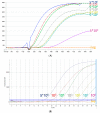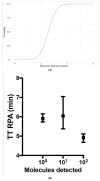Rapid Extraction and Detection of African Swine Fever Virus DNA Based on Isothermal Recombinase Polymerase Amplification Assay
- PMID: 34578312
- PMCID: PMC8472937
- DOI: 10.3390/v13091731
Rapid Extraction and Detection of African Swine Fever Virus DNA Based on Isothermal Recombinase Polymerase Amplification Assay
Abstract
African swine fever virus (ASFV) is the causative agent of a deadly disease in pigs and is spread rapidly across borders. Samples collected from suspected cases must be sent to the reference laboratory for diagnosis using polymerase chain reaction (PCR). In this study, we aimed to develop a simple DNA isolation step and real-time recombinase polymerase amplification (RPA) assay for rapid detection of ASFV. RPA assay based on the p72 encoding B646L gene of ASFV was established. The assays limit of detection and cross-reactivity were investigated. Diagnostic performance was examined using 73 blood and serum samples. Two extraction approaches were tested: silica-column-based extraction method and simple non-purification DNA isolation (lysis buffer and heating, 70 °C for 20 min). All results were compared with well-established real-time PCR. In a field deployment during a disease outbreak event in Uganda, 20 whole blood samples were tested. The assay's analytical sensitivity was 3.5 DNA copies of molecular standard per µL as determined by probit analysis on eight independent assay runs. The ASFV RPA assay only detected ASFV genotypes. Compared to real-time PCR, RPA diagnostic sensitivity and specificity were 100%. Using the heating/lysis buffer extraction procedure, ASFV-RPA revealed better tolerance to inhibitors than real-time PCR (97% and 38% positivity rate, respectively). In Uganda, infected animals were identified before the appearance of fever. The ASFV-RPA assay is shown to be as sensitive and specific as real-time PCR. Moreover, the combination of the simple extraction protocol allows its use at the point of need to improve control measures.
Keywords: African swine fever virus; DNA extraction; molecular detection; recombinase polymerase amplification.
Conflict of interest statement
The authors declare no conflict of interest.
Figures




Similar articles
-
Development of a real-time loop-mediated isothermal amplification (LAMP) assay and visual LAMP assay for detection of African swine fever virus (ASFV).J Virol Methods. 2020 Feb;276:113775. doi: 10.1016/j.jviromet.2019.113775. Epub 2019 Nov 11. J Virol Methods. 2020. PMID: 31726114
-
KP177R-based visual assay integrating RPA and CRISPR/Cas12a for the detection of African swine fever virus.Front Immunol. 2024 Apr 9;15:1358960. doi: 10.3389/fimmu.2024.1358960. eCollection 2024. Front Immunol. 2024. PMID: 38655256 Free PMC article.
-
Development of cross-priming amplification for direct detection of the African Swine Fever Virus, in pig and wild boar blood and sera samples.Lett Appl Microbiol. 2016 May;62(5):386-91. doi: 10.1111/lam.12569. Lett Appl Microbiol. 2016. PMID: 27002564
-
Virological diagnosis of African swine fever--comparative study of available tests.Virus Res. 2013 Apr;173(1):150-8. doi: 10.1016/j.virusres.2012.10.022. Epub 2012 Nov 3. Virus Res. 2013. PMID: 23131492 Review.
-
Overview of Modern Commercial Kits for Laboratory Diagnosis of African Swine Fever and Swine Influenza A Viruses.Viruses. 2024 Mar 26;16(4):505. doi: 10.3390/v16040505. Viruses. 2024. PMID: 38675848 Free PMC article. Review.
Cited by
-
Rapid detection of hepatitis C virus using recombinase polymerase amplification.PLoS One. 2022 Oct 25;17(10):e0276582. doi: 10.1371/journal.pone.0276582. eCollection 2022. PLoS One. 2022. PMID: 36282844 Free PMC article.
-
Development of a ladder-shape melting temperature isothermal amplification (LMTIA) assay for detection of African swine fever virus (ASFV).J Vet Sci. 2022 Jul;23(4):e51. doi: 10.4142/jvs.22001. Epub 2022 May 2. J Vet Sci. 2022. PMID: 35698807 Free PMC article.
-
Rapid visual detection of Giardia duodenalis in faecal samples using an RPA-CRISPR/Cas12a system.Parasitol Res. 2024 Apr 4;123(4):176. doi: 10.1007/s00436-024-08197-y. Parasitol Res. 2024. PMID: 38573530
-
Advanced Strategies for Developing Vaccines and Diagnostic Tools for African Swine Fever.Viruses. 2023 Oct 28;15(11):2169. doi: 10.3390/v15112169. Viruses. 2023. PMID: 38005846 Free PMC article. Review.
-
Stability of African swine fever virus genome under different environmental conditions.Vet World. 2023 Nov;16(11):2374-2381. doi: 10.14202/vetworld.2023.2374-2381. Epub 2023 Nov 27. Vet World. 2023. PMID: 38152254 Free PMC article.
References
MeSH terms
Substances
LinkOut - more resources
Full Text Sources

